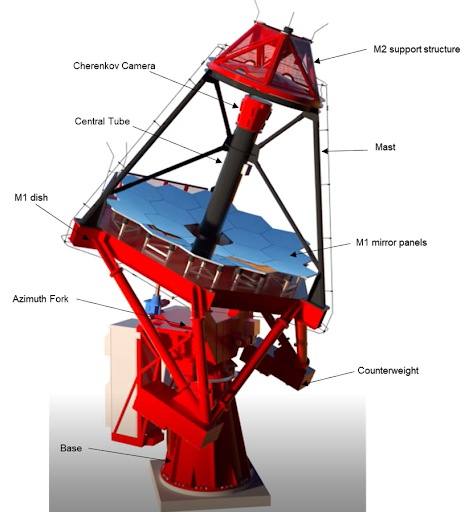Telescope description
The main subsystems of the ASTRI telescope are:
- Mechanical Structure
- Optics
- Cherenkov Camera
Mechanical Structure
The ASTRI telescope adopts an alt-azimuthal design in which the azimuth axis allows a rotation range of ±270o. The primary mirror dish, which supports the primary mirror, is mounted on an azimuth fork, which allows rotation around the elevation axis from 0 to +91o. The mast structure, that supports the secondary mirror and the camera, is placed on the primary mirror dish.
Optics
The optical design is based on a modified (Vassiliev et al., 2007) Schwarzschild-Couder configuration. This configuration allows a better correction of aberrations at large incident angles even for small focal ratios and hence it facilitates the construction of compact telescopes. This optical system is an attractive solution since it enables good angular resolution across the entire field of view and allows reducing the focal length and therefore the physical pixel and overall camera size.
The primary mirror (M1) is segmented while the secondary (M2) is monolithic. The primary is composed of a set of 18 hexagonal-shaped panels. The profiles of both mirrors are aspheric with substantial deviations from the main spherical component. The primary mirror has a diameter of 4.3m while the secondary mirror diameter is 1.8m. The primary-to-secondary distance is 3m and the secondary to camera distance 0.52m. This optical setup delivers a plate scale of 37.5mm/o, an equivalent focal length of 2150mm and an effective area of about 5m2.
Cherenkov Camera
The small plate scale resulting from the optical design leads to a Cherenkov camera of compact dimensions. This, in turn, allows the use of silicon photomultipliers (SiPM) as focal plane detectors. The SiPM detectors chosen for the ASTRI Mini-Array Cherenkov cameras are those of LVR3 series produced by Hamamatsu photonics. They are uncoated and have linear dimensions of 7×7 mm. To cover the corrected field of view of the telescope 2368 pixels are needed. The pixels are grouped in matrices of 8×8 pixels. 37 matrices are arranged to adapt to the curved focal plane of the telescope. The characteristics of the optical system coupled with the physical characteristics of the SiPM detectors yields an angular pixel size of 0.19o and a field of view of 10.5o. Furthermore, more than 80% of the light emitted by a point source is collected within the dimensions of a pixel over the full field of view of the telescope.
This post is also available in: Italian

